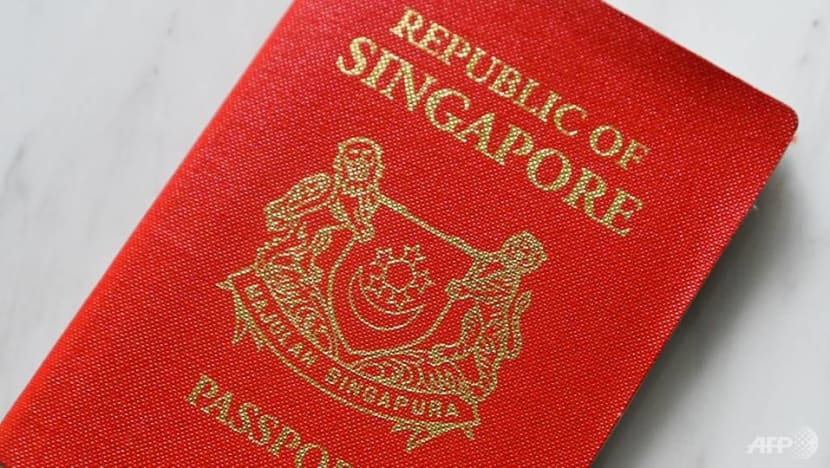NRIC, passport applications among e-services to be made available on ICA app

A Singapore passport. (File photo: AFP/Roslan Rahman)
SINGAPORE: The public can apply for NRICs and passports as well as extend visit passes on the MyICA mobile application by this year.
The Immigration and Checkpoints Authority (ICA) will also make available more digital documents and allow them to be applied for digitally, including birth and death certificates, long-term visit passes and student’s passes.
“This makes these processes completely digital end-to-end, and we will no longer need to worry about losing such important documents,” Second Minister for Home Affairs Josephine Teo told Parliament during her ministry’s Committee of Supply debate on Thursday (Mar 3).
“This also saves time spent on travelling and collecting physical documents at ICA.”
Nevertheless, Mrs Teo said ICs and passports will remain as physical documents, as current legislation still requires ICs to be presented physically in certain settings, while passports need to adhere to international standards.
The new services come as the Home Team speeds up the digitalisation of services to minimise physical touchpoints and to reach more Singaporeans safely and conveniently amid COVID-19.
At Singapore’s checkpoints, ICA will introduce an initiative this year to allow more eligible visitors to use automated clearance facilities, without the need for prior application.
“In the longer term, most residents, long-term pass holders and visitors will be cleared through automated lanes in the passenger halls – which will be faster, more efficient and more secure,” Mrs Teo said.
She reiterated that the larger pool of travellers eligible for automated clearance will not lead to longer clearance times for Singaporeans, pointing out that the automated lanes take less than half the time to clear visitors compared to the manual counters.
“In addition, over the next three years, ICA will double the number of automated lanes at Changi Airport. All lanes can be flexibly allocated to serve specific traveller groups according to operational needs,” she added.
NEW HAZMAT SENSOR GRID
Beyond service delivery, the Home Team is also using technology to improve its operational effectiveness.
For instance, the Singapore Civil Defence Force (SCDF) will implement in the next few years a nationwide hazardous materials sensor grid to allow the early detection of hazardous materials.
“With earlier detection, SCDF will be able to quickly dispatch resources to investigate and manage the situation,” Mrs Teo said.
“The management of an incident involving hazardous materials is time critical, as these substances pose significant risks to public health, property and the environment.”
Mrs Teo also provided an update on the police’s efforts to install more than 200,000 cameras by 2030 to improve crime response, first announced in Parliament last August.
As of end-2021, the police has completed the installation of about 90,000 cameras at Housing and Development Board (HDB) blocks, multi-storey car parks, town centres, neighbourhood centres and hawker centres, Mrs Teo said, adding that it will continue to expand the coverage to more public spaces and heartland areas.
These cameras help solve and deter crime, Mrs Teo said. Reports of crimes such as unlicensed moneylending have decreased by 94 per cent from 2013 to 2021, between January and June, at about 2,100 HDB blocks installed with cameras.
The footage from these cameras are stored securely and only accessed by authorised officers, she said, adding that officers can use artificial intelligence to help analyse the high volume of footage.
Home Team officers are also equipped with tools to detect and provide intelligence on cybercrime activities.
For example, the Home Team Science and Technology Agency has developed an e-commerce surveillance tool that uses artificial intelligence to help enforcement officers sift through online listings of contraband items.
“As data mining and analysis is fully automated, this significantly reduces the enforcement efforts of contraband items from days or even weeks to a matter of hours,” Mrs Teo said.
SCDF and the police will in the first quarter of 2023 equip their emergency call operation centres with video extension capabilities.
“With that, the ops centre will be able to see what is happening on the ground, and officers arriving at the scene will be able to react quicker and better,” Mrs Teo said.
When it comes to training, the Home Team is testing new technology to make training safer and more realistic, including a police system that uses lasers and body-worn detectors during simulated tactical training, removing the need for officers to fire live rounds.
The police’s taser training system also uses computer vision technology to detect and analyse data, such as where the taser probes are targeted, removing the need for conventional targets of officers wearing protective suits.
“So over the next few years, technology will continue to be a cornerstone in our transformation journey to help meet the challenges of our evolving security environment,” Mrs Teo added.
Editor's note: This article has been updated to correct the number of police cameras that had been installed in Singapore as of the end of 2021, as well as the details of where they have been installed. We apologise for the error.















